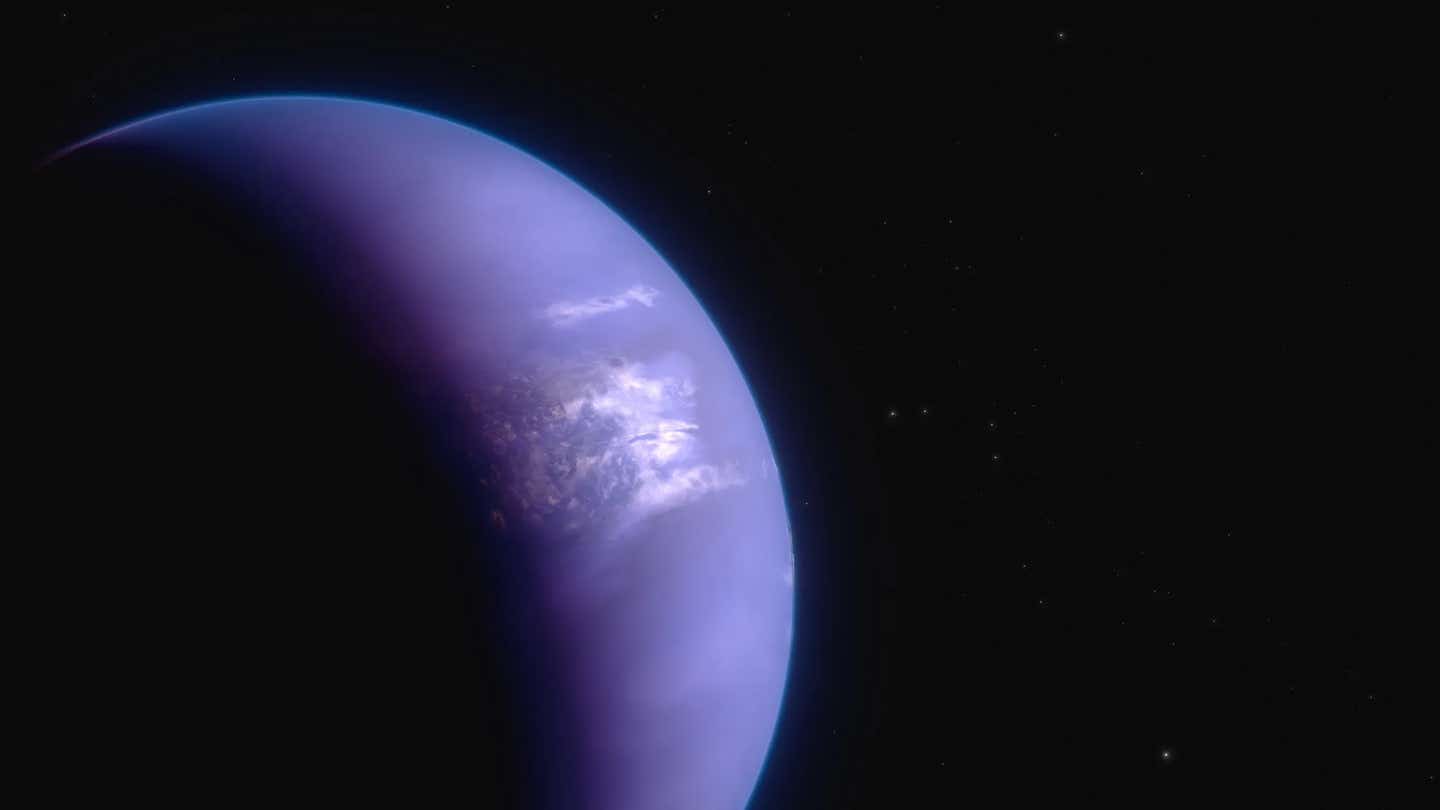NASA just mapped the weather on a planet over 280 light-years away
Scientists have inferred the presence of thick, high clouds covering the nightside of the planet, with clear skies prevailing on the dayside

This artist’s concept shows what the hot gas-giant exoplanet WASP-43 b could look like. WASP-43 b is a Jupiter-sized planet roughly 280 light-years away, in the constellation Sextans. (CREDIT: NASA, ESA, CSA, Ralf Crawford (STScI))
An international team of researchers has utilized NASA’s James Webb Space Telescope to analyze the atmospheric conditions of the hot gas-giant exoplanet known as WASP-43 b.
Through precise measurements of brightness across a wide spectrum of mid-infrared light and the application of 3D climate models, scientists have inferred the presence of thick, high clouds covering the nightside of the planet, with clear skies prevailing on the dayside. Equatorial winds, estimated to exceed speeds of 5,000 miles per hour, have been identified as mixing atmospheric gases around WASP-43 b.
This study highlights the remarkable capabilities of the James Webb Space Telescope in measuring temperature variations and detecting atmospheric gases on distant exoplanets.
This phase curve, captured by the MIRI low resolution spectrometer on NASA’s James Webb Space Telescope, shows the change in brightness of the WASP-43 system over time as the planet orbits its star. (CREDIT: Taylor J. Bell (BAERI); Joanna Barstow (Open University); Michael Roman (University of Leicester) Graphic Design: NASA, ESA, CSA, Ralf Crawford (STScI))
WASP-43 b, categorized as a "hot Jupiter" exoplanet due to its similarity in size to Jupiter, its primary composition of hydrogen and helium, and its exceptionally high temperatures, orbits its host star at a distance of merely 1.3 million miles, much closer than the distance between Mercury and the Sun.
This proximity results in the planet being tidally locked, with one side constantly facing its star and the other permanently shrouded in darkness. Despite the absence of direct radiation from the star on the nightside, strong eastward winds redistribute heat from the dayside.
Discovered in 2011, WASP-43 b has been subject to observation by various telescopes, including NASA’s Hubble and Spitzer space telescopes.
Related Stories
Taylor Bell, a researcher from the Bay Area Environmental Research Institute and lead author of the study published in Nature Astronomy, explained, “With Hubble, we could clearly see that there is water vapor on the dayside.
Both Hubble and Spitzer suggested there might be clouds on the nightside. But we needed more precise measurements from Webb to really begin mapping the temperature, cloud cover, winds, and more detailed atmospheric composition all the way around the planet.”
The team employed phase curve spectroscopy, a technique that involves measuring minute changes in the brightness of the star-planet system as the planet orbits its star, due to its short orbital period of 19.5 hours. By utilizing Webb’s Mid-Infrared Instrument (MIRI) to capture light from the WASP-43 system at intervals of 10 seconds over more than 24 hours, researchers were able to calculate temperature variations across the planet.
This set of maps shows the temperature of the visible side of the hot gas-giant exoplanet WASP-43 b, as it orbits its star. The dayside of the planet is visible just before and after it passes behind the star. (CREDIT: Taylor J. Bell (BAERI); Joanna Barstow (Open University); Michael Roman (University of Leicester) Graphic Design: NASA, ESA, CSA, Ralf Crawford (STScI))
The collected data indicates an average temperature of nearly 2,300 degrees Fahrenheit (1,250 degrees Celsius) on the dayside, contrasting with the cooler temperature of 1,100 degrees Fahrenheit (600 degrees Celsius) on the nightside. Additionally, the data helps identify the hottest spot on the planet, known as the “hotspot,” which is slightly offset eastward from the point directly facing the star due to supersonic winds.
Michael Roman, a co-author from the University of Leicester in the U.K., praised Webb’s sensitivity and stability in mapping temperature variations.
To interpret the temperature map, the team employed complex 3D atmospheric models akin to those used in Earth's meteorology and climatology. Analysis suggests that the nightside of WASP-43 b likely features a thick layer of high clouds, inhibiting the escape of infrared light into space and resulting in a dimmer appearance compared to a cloud-free nightside.
In addition to temperature mapping, the broad spectrum of mid-infrared light captured by Webb facilitated the measurement of water vapor and methane around the planet. Joanna Barstow, a co-author from the Open University in the U.K., noted the absence of methane in the atmosphere, contrary to expectations.
This absence suggests the presence of high wind speeds, estimated at approximately 5,000 miles per hour, which prevent the accumulation of methane on the nightside. The rapid mixing of gases between the dayside and nightside, driven by these intense winds, maintains uniform atmospheric chemistry across WASP-43 b, a phenomenon not previously discernible with previous telescopic observations.
Global temperature map of the hot gas-giant exoplanet WASP-43 b. (CREDIT: NASA, ESA, CSA, Ralf Crawford (STScI))
This research underscores the invaluable contributions of the James Webb Space Telescope in advancing our understanding of exoplanetary atmospheres and paves the way for further discoveries in the field of exoplanet science.
The MIRI observation of WASP-43 b was conducted as part of the Webb Early Release Science programs, which are providing researchers with a vast set of robust, open-access data for studying a wide array of cosmic phenomena.
For more science stories check out our New Discoveries section at The Brighter Side of News.
Note: Materials provided above by the The Brighter Side of News. Content may be edited for style and length.
Like these kind of feel good stories? Get the Brighter Side of News' newsletter.
Joshua Shavit
Science & Technology Writer | AI and Robotics Reporter
Joshua Shavit is a Los Angeles-based science and technology writer with a passion for exploring the breakthroughs shaping the future. As a contributor to The Brighter Side of News, he focuses on positive and transformative advancements in AI, technology, physics, engineering, robotics and space science. Joshua is currently working towards a Bachelor of Science in Business Administration at the University of California, Berkeley. He combines his academic background with a talent for storytelling, making complex scientific discoveries engaging and accessible. His work highlights the innovators behind the ideas, bringing readers closer to the people driving progress.



